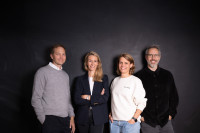Co-Creation: An Industry Stuck in Compromise Mode
200 Zeichen Lorem ipsum dolor sit amet, consectetuer adipiscing elit. Aenean commodo ligula eget dolor. Aenean massa. Cum sociis natoque penatibus et magnis dis parturient montes, nascetur ridiculus mus. Donec quu.
Kim Notz
27. November 2024
The other day, I heard that dreaded sentence again: “We absolutely need a workshop to develop the strategy and first ideas together.” A familiar refrain—one that increasingly feels like a reflex—and one that, behind closed doors, often sparks a collective eye-roll. Because deep down, we know how this usually plays out: the idea sounds good at first, but what follows are endless rounds of alignment, where the creative spark is more often smothered than ignited. Another day lost to compromises and mediocre results, dressed up as “co-creation.” Yet nobody says it out loud, because co-creation is still treated as the gold standard of modern collaboration. But why, exactly?
The Illusion of Equality: Why Co-Creation Fails
Co-creation undoubtedly comes with noble intentions. The idea of treating clients and agencies as equal partners feels not only modern, but respectful. For a long time, I too believed co-creation was the key to effective solutions—until reality proved otherwise. In practice, the ideal often unravels: complex coordination processes, endless workshops, and the pressure to accommodate every voice regularly lead to a loss of creativity.
As Rob Cross, author of Beyond Collaboration Overload, has shown, employees now spend 85% of their working time in collaborative processes. This overdose of joint idea generation doesn’t just hurt productivity—it often produces maximally average outcomes. An ironic twist for a model designed to deliver excellence.
Lorem ipsum dolor sit amet, consectetuer adipiscing elit.
The problem lies in equating harmony with quality. Great ideas rarely emerge in rooms where consensus is the ultimate goal. They demand courage, clear leadership, and decisive perspectives—not committees where every voice carries equal weight. Too often, co-creation becomes a brake on the very boldness needed to produce groundbreaking ideas.
Time as a Precious Commodity
Another key argument against excessive co-creation is the enormous investment of time. In an economy where future viability depends on agility, endless rounds of alignment feel like relics from another era. Companies and agencies operate in markets that demand swift decisions. Co-creation, however, often produces a dynamic that slows projects down instead of moving them forward.
This loss of efficiency weighs especially heavily at a time of tight budgets. Resources that clients and agencies pour into workshops and lengthy coordination are then missing where they’re needed most—namely in the agency’s true area of strength: developing bold, distinctive ideas. Creatives end up being reduced to moderators, juggling competing client interests rather than shaping ideas independently.
Rob Cross’s research shows that top performers can reclaim up to 24% of their time by actively questioning inefficient coordination processes. That kind of clarity is precisely what most co-creative formats lack. Instead, they tend to dissolve into endless discussions, leaving little space for real breakthroughs.
Clear Roles for Better Results
Effective collaboration doesn’t require radical equality—it requires clear role definition. Marketers and agencies bring different but complementary strengths to the table: clients contribute valuable market knowledge and clear strategic objectives, while agencies add fresh perspectives and unfiltered creativity. This interplay only works if both sides focus on their core competencies. The roles should complement each other, not blur together.
Lorem ipsum dolor sit amet, consectetuer adipiscing elit.
A healthy dose of leadership is essential to keep creative processes productive. Clients should have the courage to create space for creativity and trust that agencies will use it well. In return, agencies must have the confidence to stand by their ideas—even when those ideas don’t align with expectations of consensus.
Workshops and check-ins remain important elements of collaboration, but they shouldn’t dominate the creative process. The best results emerge when such formats are used to spark insights, not smother them under layers of compromise.
Creativity Needs Leadership, Not Committees
The history of successful campaigns makes one thing clear: great ideas rarely come from consensus. They are the product of radical thinking, bold decisions, and a willingness to take risks. Co-creation may sound impressive as a buzzword, but its impact remains limited when harmony and consensus dominate the process.
The future belongs to those who take responsibility—for bold visions and clear outcomes. What’s needed is not the illusion of equality, but spaces where experts can do what they do best: use their passion and expertise to create extraordinary ideas. Only then do we get work that doesn’t settle for mediocrity, but sets the standard.
Find more here:
Kontakt





